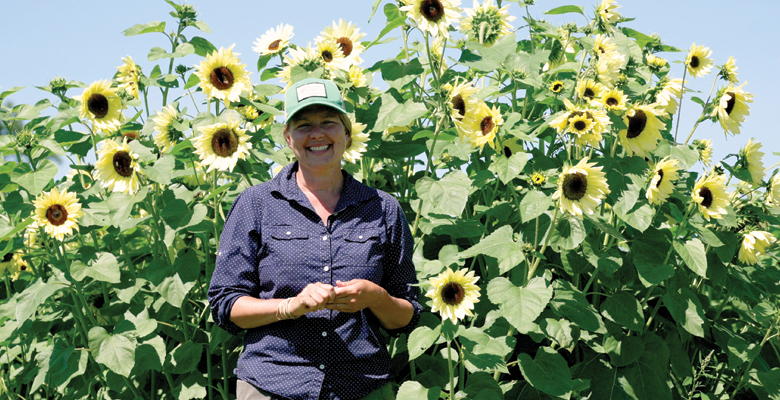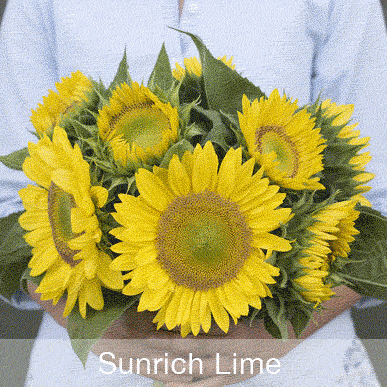- Choosing Sunflower Varieties | Single-Stem, Branching, Pollenless or "Regular"?
- Tall Sunflower Varieties | Comparison Chart (PDF)
- Video: ProCut® 'Orange Excel' | Excellent, first-to-market sunflowers + field performance
- Tall (Single Stem) Sunflowers | Key Growing Information
- 3 Sunflower Succession Planting Programs for Maximum Quality & Yield
- Single-Stem Sunflower (Helianthus annuus) Production | Tech Sheet (PDF)
- Video: Sunflower Production | Planning, Spacing & Sequencing Tips
- Dwarf Sunflowers | Key Growing Information
- Branching Sunflowers | Key Growing Information
- Video: 'Sonja' & 'Soraya' Branching Sunflowers
- Perennial Sunflowers | Key Growing Information
- 3 Easy, Reliable, Productive Cut Flowers: Sunflowers, Zinnias & Rudbeckia
- Cut-Flower Harvesting & Post-Harvest Care | Best Practices from Pros in the Slow Flower Community
- Cut-Flower Kit | Guide for Market Growers (PDF)
- Getting Started in Cut-Flowers | Top 15 Cuts
- Heat & Drought: How Flower Farmers Are Adapting to Changing & Challenging Climatic Conditions
- Pricing & Profitability for Flower-Farmers | Pointers from a Diversity of Pros
- Sustainable Farming Methods | A Survey of Flower Farmers' Best Practices
- Just Add Flowers | An Introduction to Companion Planting for Vegetable & Herb Gardeners
- Slow Flowers | Celebrating Fifth-Season Regional Design Elements
- Succession-Planting Flowers | Scheduling & Planning, Sowing Frequency, Recordkeeping & Recommendations
- Instructions for Growing Sunflower Shoots | Tech Sheet (PDF)
- Jang JP Roller Trial | SUNFLOWER VARIETIES Cross-Reference Chart (XLSX)
- ProCut Series® Sunflowers—Comparison of Orange Varieties
- 2019 American Flowers Week: Combining the Art of Floral Design & Couture
- Sunflower Growing Tips: Single-Stem vs. Branching
- ProCut Horizon® Sunflower Variety
- 'Desert Sun' | Branching Sunflower Variety
- How to Air-Dry Cut Flowers | Easy Instructions from Johnny's
- Modern Everlastings: Guidance on Dried Botanicals from 4 Far-flung Farmer-Florists
- Top 10 Cut-Flower Varieties for Direct Seeding
- Johnny's Edible Flower Guide | Printable 4-pp Brochure (PDF)
- Johnny's Planting & Harvesting Programs
- Video: Tips & Recommendations for Dried Flowers • Tutorial with Joy Longfellow
Choosing Sunflower Varieties
Advantages & Disadvantages of Various Types of Sunflowers
Sunflowers are a popular crop, and a great way for vegetable growers to experiment with adding flowers to the product mix. With more than 50 cultivars to choose from, getting started with sunflowers can be a bit daunting. This article explains basic advantages and disadvantages of the various types and offers some recommendations for choosing the sunflower varieties that best suit your needs and preferences.
The 2 Primary Types of Sunflowers
There are two basic types of cut-flower sunflowers:
These two types are so different from one another that I almost think of them as different crops. I grow the single-stem types because they are preferred in my market, but I can see where some growers would do better with the branching types. Here are some pros and cons of each type.
Choosing Sunflower Varieties
Lynn Byczynski was growing organic vegetables and cut flowers for market when she decided to create a magazine that would help market gardeners nationwide share experiences and information. Her first issue of Growing for Market appeared in January 1992; GFM has been published continuously ever since and is renowned in the market-gardening world for realistic articles that provide practical, how-to information about growing and selling produce and flowers.
Byczynski and her family have been growing vegetables and cut flowers since 1988, selling through CSAs, at farmers' markets, to chefs, grocery stores, and florists. They currently grow cut flowers and hoophouse tomatoes on about 2 acres of their 20-acre farm near Lawrence, Kansas.
She is also the author/editor of two of our favorite books about market farming, The Hoophouse Handbook and The Flower Farmer.
SINGLE-STEM, POLLENLESS SUNFLOWERS
If I had to pick the easiest, most reliable sunflowers for the beginning grower as well as for no-nonsense succession-planting and harvesting, I would recommend the 'Sunrich' series or the 'Pro Cut' series, both of which are Single-stem varieties.
Single-stem sunflowers are pollenless hybrids, which means they do not drop pollen on furniture, tablecloths, and clothing, as non-hybrid sunflowers do. Pollenless sunflowers possess only female characteristics. They do not shed pollen, are less apt to be allergenic, and last longer in a vase. Pollenless sunflowers have abundant nectar which means they are still attractive to bees and butterflies, and will form seeds if there are other sunflowers with pollen nearby.
Continuing on the plus side for single-stem sunflowers, many of these varieties are really quick to bloom, needing just 60 days from seeding date to reach harvestability. In addition, there is a good selection of day-neutral single-stem varieties that can be grown in a hoophouse early in spring or late in fall. (See our article on how day length affects flowering for more detail.)
Single-stemmed plants are more mutable than branching types in regard to the size of the flower you can produce. You can crowd the plants into 6" x 6" spacing to produce smaller, bouquet-sized flowers; or you can space them 12" apart to produce dinner-plate-sized flowers. (See our video on planning, spacing, and sequencing tips for sunflowers to learn more about how spacing influences bloom size.)
Single-stem varieties additionally have strong, thick stems and flowers of substance that make a statement and fill out a bouquet, which endears them to florists. And their vase life is amazing—up to 2 weeks in plain water.
On the other hand, single-stem sunflowers produce just one single flower from one single seed. (Although a few cultivars may send up small secondary flowers in mid-summer, this is not the norm.) This means you need to succession-plant single-stem sunflowers every 10–14 days, all season, if you want to have a continuous supply. If you're selling your blooms, you will need to charge more for single-stemmed cuts to make a good return on your investment. You can treat this as an opportunity, nonetheless—see our 3 Sunflower Succession-Planting Programs to learn how.
Top-10 Single-Stem Sunflowers
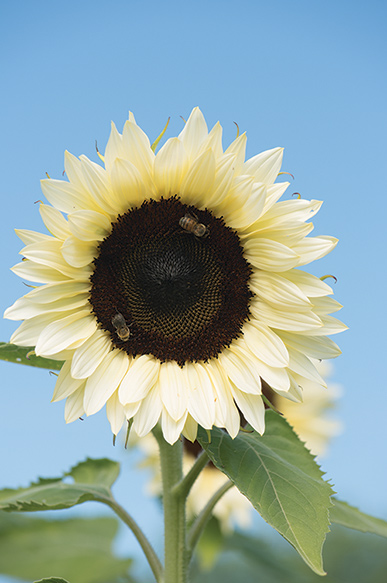
- Earliest variety: 'ProCut Orange Excel'
- Best selection for downy mildew-resistance: 'ProCut Orange DMR'
- Most uniform in appearance and harvest date: 'ProCut Horizon'
- Perfect for looking "pale and interesting": 'ProCut White Lite' & 'ProCut White Nite'
- Best single-stemmed sultry redhead: 'ProCut Red'
- Most uniform in appearance and harvest date: 'ProCut Horizon'
- Wins hearts for its upfacing "lollipop" appearance: 'Vincent's Choice'
- Best for winter production in the South; tall and stately, with classical good looks: 'Full Sun Improved'
- Beloved standout in our trials, year after year: 'Double Quick Orange'
- Best banner yields of delicious edible seeds: 'Royal Hybrid 1121'
BRANCHING SUNFLOWERS
Branching sunflower varieties produce numerous blooms over a long period of time, so they don't need to be succession-planted as frequently. There are numerous unusual colors among the branching varieties, including burgundy, chocolate, bronze, and bicolors. Most of the doubles (with blooms that have more than one layer of petals) are branching types. In other words, this category has a lot of pizzazz.
On the other hand, the stems on most branching sunflowers are neither as long nor as strong as those of single-stem varieties. Most need 65 days or more to bloom, and they also require a lot more space; we recommend you plant the branching types 18" apart. And their lengthier production cycle lends insects and disease more opportunity to attack the plants. Yet by growing branching types, you are at the same time sustaining the beneficial organisms that rely on them. Many branching cultivars do produce copious amounts of pollen—look for those identified as pollenless if you think this is going to be a problem for your customers. And as a group, the branching varieties are not especially long-lived in the vase, some with just 5 days of vase life.
Top-10 Branching Sunflowers
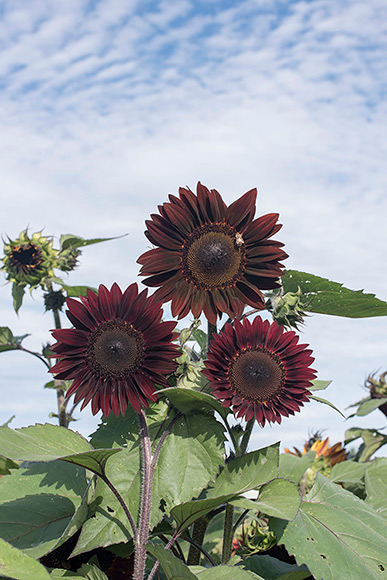
- Best branching varieties for cut-flower bouquets, with strong stems and small, uniform upright blooms: 'Sonja' & 'Soraya'. (Both form pollen, however, in case you need to avoid it.) 'Soraya' is also the first All-America Selections Award-winning sunflower.
- Best light-bloomed, quick-growing, pollenless variety: 'Buttercream'
- Best strong-stemmed, pollenless burgundy variety: 'Rouge Royale' (aka 'Moulin Rouge')
- Best multicolored, pollenless, day-length-neutral variety: 'Strawberry Blonde'
- Best mix for roadside displays and cutting gardens, with nice color balance and a diversity of color and shape: 'Summer Breeze Mix'
- Best for bright gold, lavishly-double blooms borne atop towering plants: Organic 'Goldy Double'
- Choice of chocoholics and bee devotees: 'Chocolate'
- Best sunflower for fragrant bouquets: 'Florenza'
- Best for blasting out consistent, bicolor blooms on short, sturdy plants: 'Firecracker'
- Cuddle-worthy children's favorite for container-growing: 'Teddy Bear'
More to Explore
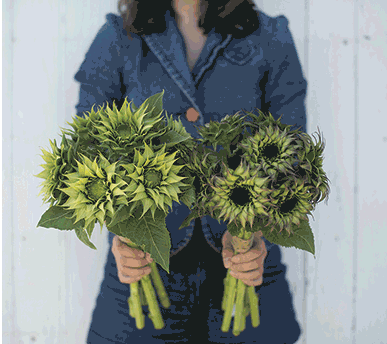
These are just the basic considerations in choosing varieties, and each year new cultivars are introduced that help to dispel the objections to each type. There are now branching varieties that bloom in 60 days and have no pollen, such as 'Buttercream' and 'Rouge Royale'; there are single-stem varieties that are fully double, such as 'Double Quick Orange'; and there are mesmerizing bicolors such as 'ProCut Red/Lemon Bicolor'.
As for my recommendation of the Sunrich and ProCut series, I see these as offering a strong sunflower with the traditional appearance that appeals to all kinds of people. Hence, they are easy to grow and sell. They are not finicky about when you grow them, and there are plenty of color choices among the two series. If you just want a basic sunflower, these series provide the perfecting starting point. And for the advanced as well as the aspirational grower, these two series form an excellent basis for sunflower succession planting and harvesting.
There are so many more sunflower varieties to explore, with single-stem, branching, tall, dwarf, pollenless, and "regular" types, as well as novel shapes, sizes, and multicolor options. Over time, you will surely want to explore other options to find new combinations that suit your needs and preferences.


